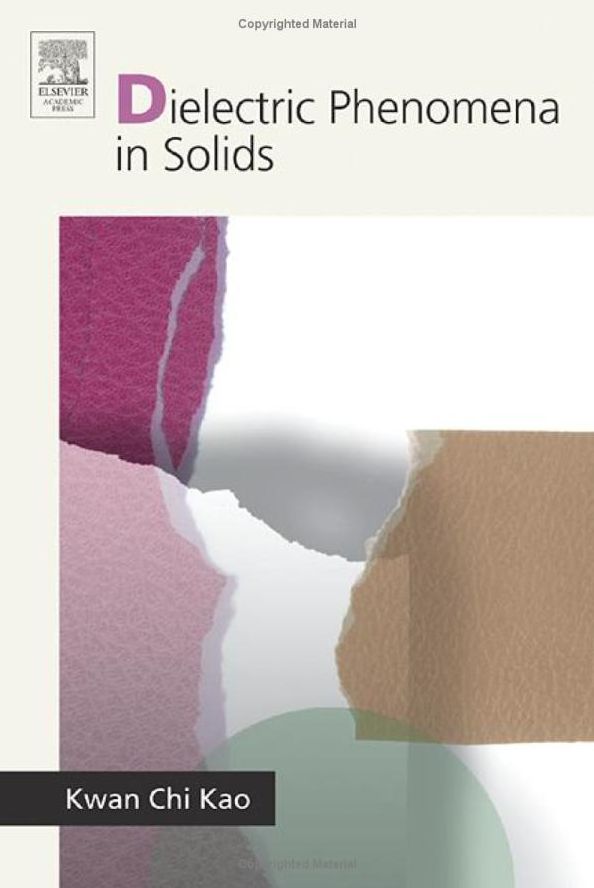السلام عليكم
Dielectric Phenomena in Solids

Kwan Chi Kao "Dielectric Phenomena in Solids"
Academic Press | 2004-05-11 | ISBN: 0123965616 | 579 pages | PDF | 4.1 MB
This book, Dielectric Phenomena in Solids, would appeal to the interests of many of our readers, especially those who work with piezoelectric, ferroelectric, pyroelectric, electrets, and electro-optic solid materials. Many of the materials described would be used in sensors, microphones, pulse generators, capacitors, and electro-optical devices. More specifically, the ferroelectrics covered are ceramics, barium titinates, KDP, Rochelle salt, TGS, PZT, and PVDF. Other materials are also covered in electrets and silicon photovoltaics. The response of these types of solid dielectrics to externally applied electric fields, mechanical stress, and temperature are the main focus of this text along with a very good description of fundamental dielectric theory. With mathematical derivations keep to a minimum, the physical insight into dielectric phenomena is emphasized. This text can be broken down into three sections. While an understanding of dielectric phenomena requires a basic knowledge of electromagnetics, the beginning chapters appropriately cover the fundamentals - Maxwell's equations, magnetization, electric polarization and relaxation, and optical/electro-optic processes. The next two chapters describe material response characteristics of ferroelectric, piezoelectric, and pyroelectric materials and electret formation. In addition to the above-mentioned materials, there are well-explained details given on piezoelectric, pyroelectric, and electret mechanisms. There are also a few applications for pyroelectric and electret materials. The remaining three chapters detail topics of charge carrier injection for electrical contacts, electrical and photoconduction, and electrical aging, discharge, and breakdown. The section on charge injection from electrodes to insulators would be of interest to those who work with any type of insulator to electrode interface. Also, for those interested in dielectric breakdown and measurements of electrical aging, the final chapter would be of interest. Along with the theory on electrical aging in general and specifically on polyethylene, there are descriptions of measurement techniques used to measure the electrical aging of insulators with typical graphs for polyethylene. Since there are very few books written specifically on dielectric phenomena in general, this book would be an excellent resource to our readers who develop ferroelectric materials and solid state dielectrics and for those in need of an up-to-date, easy to read reference on dielectric phenomena in general, especially on solid dielectrics. - John J. Shea IEEE Electrical Insulation Magazine 2004 In Dielectric Phenomena in Solids, Kao presents a thorough examination of solid dielectric materials and what happens to them when acted upon by various forces such as electromagnetic fields, mechanical stress and temperature...Researchers and graduate students will find this a useful reference source if not a graduate level textbook.
[hide][/hide]
[hide]Dielectric Phenomena in Solids

Kwan Chi Kao "Dielectric Phenomena in Solids"
Academic Press | 2004-05-11 | ISBN: 0123965616 | 579 pages | PDF | 4.1 MB
This book, Dielectric Phenomena in Solids, would appeal to the interests of many of our readers, especially those who work with piezoelectric, ferroelectric, pyroelectric, electrets, and electro-optic solid materials. Many of the materials described would be used in sensors, microphones, pulse generators, capacitors, and electro-optical devices. More specifically, the ferroelectrics covered are ceramics, barium titinates, KDP, Rochelle salt, TGS, PZT, and PVDF. Other materials are also covered in electrets and silicon photovoltaics. The response of these types of solid dielectrics to externally applied electric fields, mechanical stress, and temperature are the main focus of this text along with a very good description of fundamental dielectric theory. With mathematical derivations keep to a minimum, the physical insight into dielectric phenomena is emphasized. This text can be broken down into three sections. While an understanding of dielectric phenomena requires a basic knowledge of electromagnetics, the beginning chapters appropriately cover the fundamentals - Maxwell's equations, magnetization, electric polarization and relaxation, and optical/electro-optic processes. The next two chapters describe material response characteristics of ferroelectric, piezoelectric, and pyroelectric materials and electret formation. In addition to the above-mentioned materials, there are well-explained details given on piezoelectric, pyroelectric, and electret mechanisms. There are also a few applications for pyroelectric and electret materials. The remaining three chapters detail topics of charge carrier injection for electrical contacts, electrical and photoconduction, and electrical aging, discharge, and breakdown. The section on charge injection from electrodes to insulators would be of interest to those who work with any type of insulator to electrode interface. Also, for those interested in dielectric breakdown and measurements of electrical aging, the final chapter would be of interest. Along with the theory on electrical aging in general and specifically on polyethylene, there are descriptions of measurement techniques used to measure the electrical aging of insulators with typical graphs for polyethylene. Since there are very few books written specifically on dielectric phenomena in general, this book would be an excellent resource to our readers who develop ferroelectric materials and solid state dielectrics and for those in need of an up-to-date, easy to read reference on dielectric phenomena in general, especially on solid dielectrics. - John J. Shea IEEE Electrical Insulation Magazine 2004 In Dielectric Phenomena in Solids, Kao presents a thorough examination of solid dielectric materials and what happens to them when acted upon by various forces such as electromagnetic fields, mechanical stress and temperature...Researchers and graduate students will find this a useful reference source if not a graduate level textbook.
[hide][/hide]
http://www.mediafire.com/view/h0b90jag7kqtdtu/Dielectric_Phenomena_in_Solids.pdf
[/hide]
